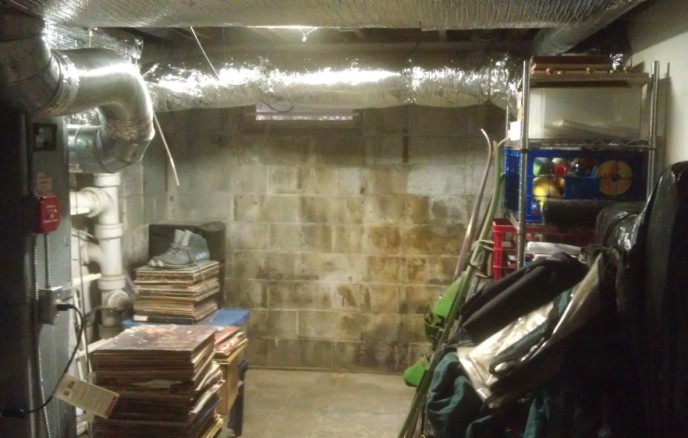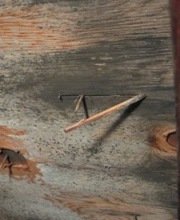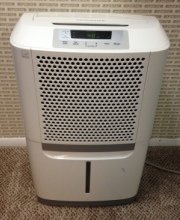Find a Mold Specialist Now
Click or Call, Toll-Free 24/7
moldy smell in your home? What you should know
You’ve probably gone into a basement or attic and noticed a moldy smell before. It is a characteristic musty odor that most people recognize. When you smell that odor, you know there is mold around somewhere.
While the mold smell tells you that there is mold around, it doesn’t tell you exactly where the mold is. You might smell mold in your basement but not see any. Mold often grows in hard-to-spot places. We’ll tell you what causes that characteristic moldy odor and how to find the mold that is causing it.
What Causes That Moldy Smell?
Gasses produced by mold, known as microbial volatile organic compounds, give off the characteristic musty odor associated with mold. The gasses themselves are usually harmless, but exposure to the mold that produces the gasses can lead to health problems.
 Mold found on basement wall after homeowner noticed a musty moldy smell
Mold found on basement wall after homeowner noticed a musty moldy smellFinding Mold
The characteristic musty smell tells you that there is mold in your house, but where is it? It’s common to smell mold but not see it. You’ll need to make a careful inspection of your home to find the mold.
To inspect for mold, you’ll need a good flashlight. A small mirror can help, as well. Mold remediation professionals often use an angled mirror with a long handler to allow them to see into hard-to-reach spaces.
You may also wish to wear an N-95 respiratory mask while inspecting for mold, especially if you’ve been experiencing any health problems you think might be caused by mold or if you have any respiratory problems such as asthma. Mold spores are very small and light, so they are easy to inhale. You don’t want to make yourself sick looking for mold.
Start by looking in the most likely places, though you should not stop there. Look under sinks, behind toilets, around bathtubs, and behind and beneath appliances that use water, such as dish washers and washing machines. Examine ceilings for signs of water damage, which may indicate mold is growing above the ceiling.
You’ll also want to look inside your heating, ventilation and air conditioning ducts, especially if you smell mold but don’t see it. Your flashlight and a mirror with a long handle will come in handy for this. The Environmental Protection Agency (EPA) recommends not running the heating or air conditioning until you are sure the system is mold-free.
It may also be necessary to look for mold inside walls or under floorboards. You may want to get a mold remediation professional to assist with this, unless you are especially handy. To look inside walls for mold, a small square of drywall is cut out and removed so that a flashlight and mirror can be used to look inside. A similar technique is used to look under floorboards. Multiple openings may need to be cut into the wall or floor so that the entire wall or floor can be examined.
If you choose to do this yourself, be sure to wear protective gear and also to take steps to prevent the inadvertent spread of mold to other areas of the home. Cutting into moldy drywall or floorboards will send literally hundreds of thousands of mold spores into the air. Inhaling the mold spores can make you ill, and if they settle on other household surfaces, mold may begin to grow there as well.
We want to stress the fact that if there is mold in one area of your home, you should look everywhere for additional mold. Mold spreads very easily and it is not unusual to find mold in multiple locations in the house.
Getting Rid of That Moldy Smell
To get rid of that characteristic musty mold smell, you’ll have to get rid of the mold. Air fresheners, disinfectant sprays, scented candles, incense and the like may temporarily cover up the musty smell but they won’t get rid of it. Covering up the moldy odor will not prevent mold-related health problems and it won’t stop mold from growing and spreading and damaging your home.
For Help Locating Mold
If you need help locating the source of the moldy smell in your home, we suggesting calling in a mold remediation professional. Experienced professionals offer free in-home consultations and inspections. They will help you locate the mold in your home, making sure you’ve found it all, and advise you about the mold removal process. You may choose to hire them for the job but you’re under no obligation to do so. To schedule a risk-free, no-cost inspection and consultation with a qualified mold remediation professional, just follow the link.
Return From Moldy Smell To Home Page
EPA: Mold Cleanup
Privacy Policy Terms and Conditions Accessibility Do Not Sell My Information Disclaimer Contact Us




